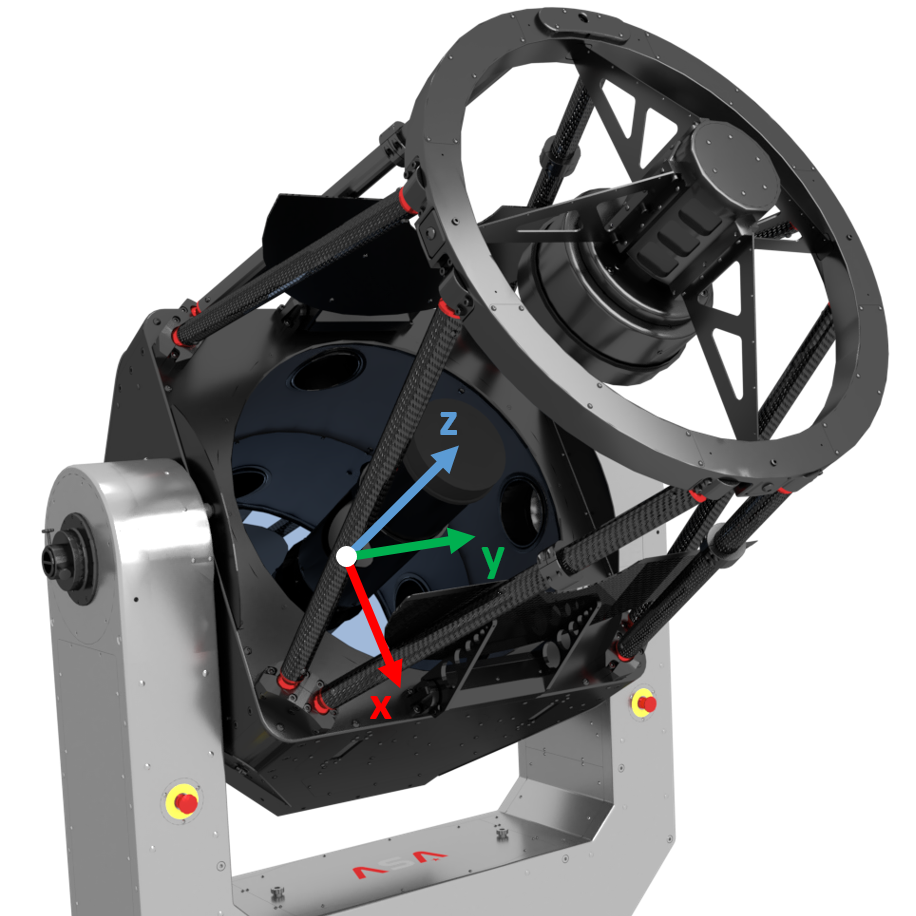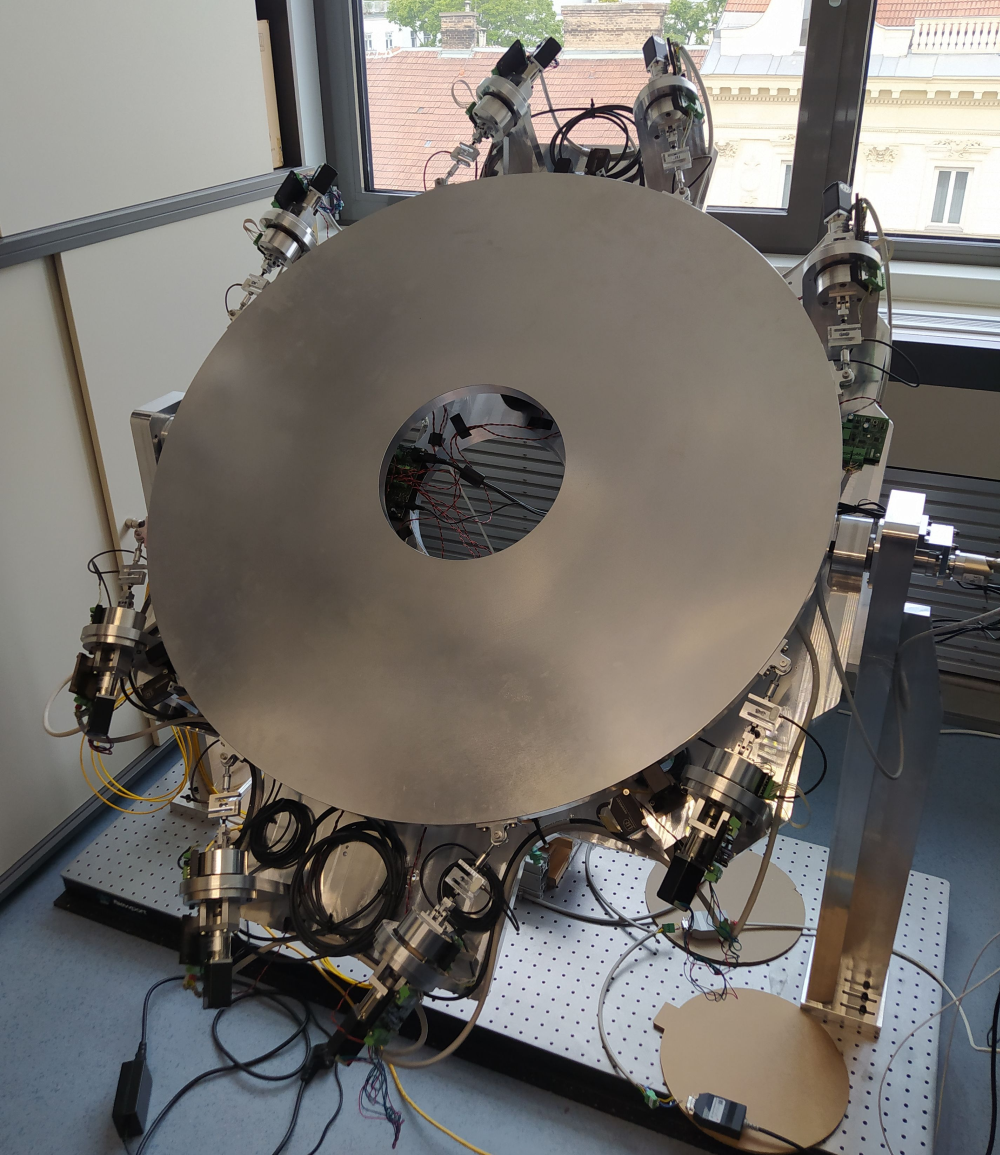
PriMActO
Goals
- Development of a systematic system design for active optics.
- Development of a modular approach for the support strcture of the primary mirror.
- Construction of primary mirror cell for an 1 m mirror with active axial and lateral support.
Description
Currently, midsized telescopes with a diameter between 0,6 m and 2,0 m are gaining increased importance in several established as well as in newly emerging applications. Optical communication with satellites in the orbit, which enables more than ten times higher data rates than available radio frequency communication systems, and the identification and tracking of space debris, in order to reduce the risk for functional satellites, are two examples for applications requiring midsized robust telescope systems with sufficient light-gathering power as a fundamental prerequisite. To guarantee appropriate reliability of these systems, a large number of optical ground stations is required. This makes a low system mass of telescopes, allowing for easy transportation and installation, as well as low production costs a desirable property.

Lab setup of the primary mirror cell with aluminum mirror.
For reducing the weight of about 1500 kg and costs for production, transportation and installation of current, comparably heavy, telescopes in the 1-m class, thin lightweight mirrors can be employed to reduce the mass of the primary mirror, which is the driving factor for overall system cost and weight. To avoid a degradation of the imaging quality caused by deformations of the thin mirror due to gravity, this project aims to develop methods for the development and integration of an active optic system into the primary mirror cell of telescopes by the industrial partner ASA Astrosysteme GmbH in the 1-m class. The active optics enables to compensate for orientation dependent gravitational sag thermally induced deformations by an active correction of the mirror by using an active axial and lateral suspension system. Following an integrated mechatronic system design approach an extremely lightweight design, a high imaging quality of the system as well as an exceptional cost efficient solution are to be obtained. In this course, a modular concept for the system design will be developed, including methods for the optimal number and placement of actuators over the mirror surface and modular highly integrated actuator-sensor-systems. An optimal system integration systematically will consider the interplay between the system components, the system requirements and the real time control system and will enable the design of lightweight telescopes with highest optical quality.
Applications
- Satellite communication
- Space debris observation
Related Publications
- C. Schwaer, A. Sinn, P. Keller, and G. Schitter, Design methodology to develop an active optics system for a thin 1-m meniscus mirror, Journal of Astronomical Telescopes, Instruments, and Systems, vol. 6, iss. 4, p. 049002-1–049002-22, 2020.
[BibTex] [Download]@article{TUW-291787, author = {Schwaer, Christian and Sinn, Andreas and Keller, Philipp and Schitter, Georg}, title = {Design methodology to develop an active optics system for a thin 1-m meniscus mirror}, journal = {Journal of Astronomical Telescopes, Instruments, and Systems}, year = {2020}, volume = {6}, number = {4}, pages = {049002-1--049002-22}, doi = {10.1117/1.JATIS.6.4.049002}, keywords = {active optics, telescopes, mirrors, lightweight design, finite element analysis, mechatronic system design} }
- C. Schwaer, A. Sinn, and G. Schitter, Mechatronic Approach towards Lightweight Mirrors with Active Optics for Telescope Systems, in Proceedings of the Joint Conference 8th IFAC Symposium on Mechatronic Systems (MECHATRONICS 2019), and 11th IFAC Symposium on Nonlinear Control Systems (NOLCOS 2019), 2019.
[BibTex] [Download]@InProceedings{TUW-281662, author = {Schwaer, Christian and Sinn, Andreas and Schitter, Georg}, title = {Mechatronic Approach towards Lightweight Mirrors with Active Optics for Telescope Systems}, booktitle = {Proceedings of the Joint Conference 8th IFAC Symposium on Mechatronic Systems (MECHATRONICS 2019), and 11th IFAC Symposium on Nonlinear Control Systems (NOLCOS 2019)}, year = {2019}, volume = {52/15}, note = {Vortrag: Joint Conference 8th IFAC Symposium on Mechatronic Systems (MECHATRONICS 2019), and 11th IFAC Symposium on Nonlinear Control Systems (NOLCOS 2019), Wien; 2019-09-04 -- 2019-09-06}, doi = {10.1016/j.ifacol.2019.11.641}, journal = {IFAC-PapersOnLine/Elsevier}, keywords = {Active Optics, Meniscus Mirror, System Analysis, Optomechatronics}, numpages = {6}, }
Project partner
- ASA Astrosysteme GmbH
Funding
- ASAP 15, FFG – Die Österreichische Forschungsförderungsgesellschaft
- ASA Astrosysteme GmbH
Contact
Univ.-Prof. Dipl.-Ing. Dr.sc.techn. Georg SchitterM.Sc. Christian Schwär
Project Staff
M.Sc. Christian SchwärDipl.-Ing. Andreas Sinn